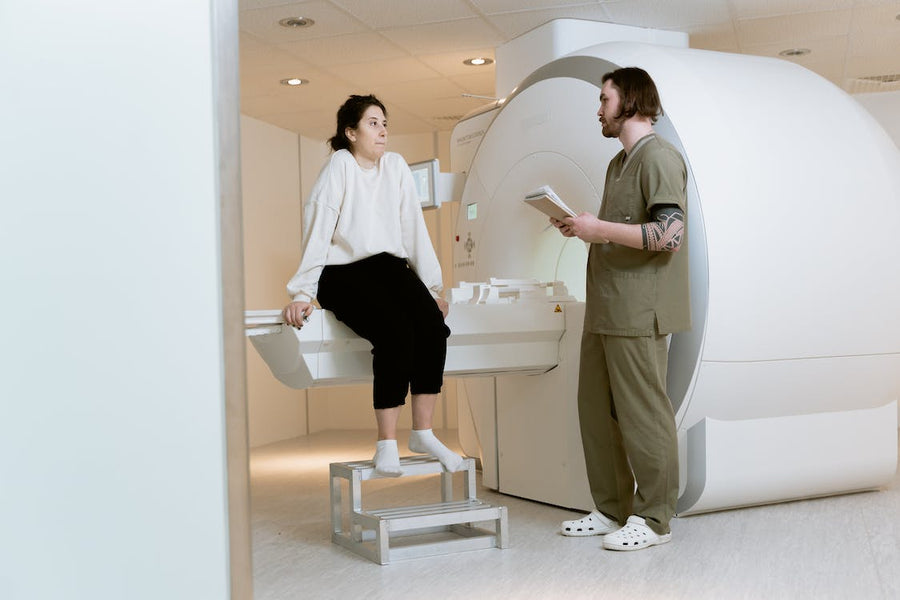How to Get Rid of Fibroids

By OBGYN Dr. Kenosha Gleaton
Uterine fibroids can cause uncomfortable symptoms, including infertility, abnormal bleeding, heavy periods, and pelvic pain. While not everyone will want or require treatment, there are some medications and surgical interventions that can help treat, shrink, or get rid of fibroids.
What are Fibroids?
Uterine fibroids, also known as leiomyomas, are non-cancerous tumors or growths found in the uterus. These growths are made of smooth muscle cells, fibroblasts, and other materials. [1] It’s estimated that up to 80% of people assigned female at birth (AFAB) will develop fibroids during their lifetime. [2] Fibroids can vary in size, shape, and location, but are always found on or around the uterus. Fibroids are most commonly seen in females aged 30 to 40 but can occur at any age. [1]
What Causes Fibroids?
We aren’t exactly sure what causes fibroids, but research points to a few different factors. We know that genetics play a role in fibroids and that estrogen and progesterone likely cause fibroids to grow. [1] Some research also suggests that fibroids begin to develop as a result of misplaced cells in the body. [1]
Do Fibroids Need to be Treated?
Not everyone with fibroids will need or want treatment. Fibroids do not always cause symptoms and may go unnoticed. In other cases, fibroids can lead to infertility or uncomfortable symptoms and may require treatment. [1] Some symptoms include heavy or painful periods, pelvic pain, rapid growth of the fibroid, and more. There are many different ways to treat fibroids that will depend on someone’s age, the size and location of fibroids, and family planning goals. [1,3] Read Home Remedies for Fibroid Pain Relief →
Are Fibroids Curable?
It is possible to treat the symptoms caused by fibroids or to shrink fibroids, but the only sure-fire way to completely cure fibroids is to remove the uterus, also known as a hysterectomy. [1,3] A hysterectomy is not a decision that is taken lightly, as someone will no longer be able to get pregnant once the uterus is removed. If the ovaries are also removed during the procedure, hormonal treatment may be necessary as menopause will occur very soon after surgery. [1,3]
How to Get Rid of Fibroids
While curing fibroids completely isn’t always an option, there are other ways to shrink or reduce the symptoms of uterine fibroids. Let's break down all the different treatment options.
Prescription Medications
Some medications may help reduce the symptoms of fibroids and in some cases, can help shrink fibroids. Unfortunately, most medications will only be used for a short period of time, and fibroids will still return to their normal size or continue to grow after medications are discontinued. [1,3]
Hormonal Birth Control
Hormonal birth control methods can be useful for controlling painful periods and heavy or abnormal bleeding. Unfortunately, estrogen and progesterone may actually cause fibroids to grow, which should be taken into account before this treatment is used. Hormonal birth control methods include the pill, patches, vaginal rings, intrauterine devices (IUDs) and others.
Hormone Agonists
Other prescription medications include gonadotropin-releasing hormone (GnRH) agonists and antagonists. These medications can usually only be used temporarily, for six months to two years, and may be used in combination with surgical methods. [1,3] Agonists work to stop the menstrual cycle and potentially shrink fibroids, while antagonists are used to treat heavy bleeding and do not shrink fibroids. There are often side effects noticed when taking these medications, such as hot flashes, bone loss, vaginal dryness, and night sweats. [1,3]
Surgery
Surgical methods may also be helpful in treating or getting rid of uterine fibroids. Surgery may include removing fibroids while leaving the uterus in place, removing the uterus, or removing the uterus and ovaries.
Myomectomy
A myomectomy is a surgery that removes uterine fibroids but leaves the uterus intact. A myomectomy may still allow someone to get pregnant, but internal scarring may also occur, which could impact fertility outcomes. [1,3] Fibroids will not regrow once they are removed, but new fibroids can develop. Research shows that myomectomy can relieve fibroid-related symptoms in up to 90% of patients. [4]
Hysterectomy
A hysterectomy is the removal of the uterus and may or may not include the ovaries. A hysterectomy is typically reserved for cases when other treatments have not worked, aren’t good options, or when the fibroids are very large and impact quality of life. [1,3] If the ovaries are removed, menopause will begin after surgery and will cause noticeable symptoms.
Medical Treatments
Other medical treatments outside of prescription medication or surgery can be used to shrink or get rid of fibroids.
Ablation and Embolization
Uterine artery embolization (UAE) is a procedure that blocks blood flow to fibroids in order to shrink them in size. [1,3] This is done using tiny particles that are injected into the blood vessels leading to the uterus. UAE is minimally invasive and has been successful in reducing the size of fibroids, however, UAE may not be the best option for people who are hoping to conceive. Some data suggests that UAE may cause an increased risk of miscarriage, and has the potential to impact the functioning of the uterus and ovaries. [3]
Endometrial ablation is a procedure that targets the lining of the uterus in order to shrink the size of fibroids. Ablation can be done using electric currents, freezing, or microwave energy. A more recent method of ablation is the Acessa procedure. This procedure uses radiofrequency ablation to destroy or shrink fibroids with heat. Depending on the ablation or UAE method, there may be fertility concerns to be aware of. [3]
MRI-Guided Ultrasound
This is a relatively new technique that used ultrasound waves to destroy fibroids. Using magnetic resonance imaging (MRI), fibroids are identified and then targeted with waves through the skin. More data is needed to speak to the efficacy of this procedure. [1,3]
Treating Fibroids When Hoping to Conceive
So what is the best treatment for fibroids if you’re hoping to conceive in the future? The truth is you may not even need to treat fibroids at all unless they’re very large or causing you discomfort. [1] Some types of fibroids can distort the lining of the uterus, making implantation more difficult, while others may not impact your fertility at all. Many providers will recommend a myomectomy, to remove fibroids without harming the uterus or blood flow to the uterus and ovaries. [1,3,5,6] There are potential risks and complications with all treatments and medications, so be sure to speak with your healthcare provider about your family planning goals and what treatment may be right for you.
If you are hoping to conceive, Natalist has products to support both female and male fertility. Some data suggests that maintaining healthy levels of certain vitamins (like vitamins A, D, B3, E, and K) may improve the size and symptoms of fibroids. [7] Shop all supplements here.
References:
- Patient FAQ: Uterine fibroids. FAQ074. American Congress of Obstetricians and Gynecologists. July 2022. Retrieved June 2023. URL.
- Sohn, G S. Cho, S. Kim, Y M. Cho, C-H. Current medical treatment of uterine fibroids. Obstet Gynecol Sci. 2018;61(2):192-201. Published online February 13, 2018. DOI: https://doi.org/10.5468/ogs.2018.61.2.192
- What are the treatments for uterine fibroids? NIH. Office of Communications. November 2 2018. URL.
- Agency for Healthcare Research and Quality (AHRQ). (2005). The FIBROID Registry: Report of Structure, Methods, and Initial Results. AHRQ Publication No. 05[06]-RG008. Retrieved June 13, 2017, from http://archive.ahrq.gov/research/fibroid/fibsum.htm
- Obed JY, Bako B, Kadas S, Usman JD, Kullima AA, Moruppa JY. The benefit of myomectomy in women aged 40 years and above: Experience in an urban teaching hospital in Nigeria. Niger Med J. 2011;52(3):158-162. doi:10.4103/0300-1652.86125
- Jeldu M, Asres T, Arusi T, Gutulo MG. Pregnancy Rate after Myomectomy and Associated Factors among Reproductive Age Women Who Had Myomectomy at Saint Paul's Hospital Millennium Medical College, Addis Ababa: Retrospective Cross-Sectional Study. Int J Reprod Med. 2021;2021:6680112. Published 2021 Nov 28. doi:10.1155/2021/6680112
- Ciebiera M, Ali M, Zgliczyńska M, Skrzypczak M, Al-Hendy A. Vitamins and Uterine Fibroids: Current Data on Pathophysiology and Possible Clinical Relevance. Int J Mol Sci. 2020;21(15):5528. Published 2020 Aug 1. doi:10.3390/ijms21155528
Reach Out, We're Here
Have questions about your order or products? For the speediest answer, check out our FAQ section. Need something else? Come find us below.
Please keep in mind our regular business hours; Monday-Friday, 9am-5pm CT.
Customer Support
support@natalist.com
Press Inquiries
media@everlyhealth.com
Business & Partnerships
team@natalist.com
Affiliates + Influencers
team@natalist.com
Job Openings
Careers Page
























